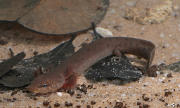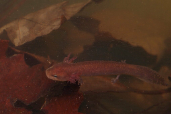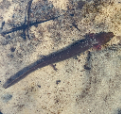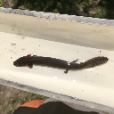Escambi Waterdog (Necturus mounti)
Description: Necturus mounti is a neotenic species of aquatic salamander with adults reaching a standard length of up to 116 mm for males and 110 mm for females. Average male snout-vent length is 108.4mm and average female snout-vent length is 94.8 mm. Males reach sizes that average 13.6 mm longer in standard length than females. This species is identified as a member of the family Proteidae by retention of external gills in adults, and the presence of four robust limbs with four toes on the hind limbs. Typically, seventeen costal grooves are present (range of 16-17). Reproductive males can be distinguished from adult females by the presence of a swollen cloaca, a cloacal lining of finger-like projections, and a spur-like tip on each side of the posterior end of the cloacal opening.
Habitat: Escambia Waterdogs occur in slow-moving streams where they are most frequently detected in accumulated piles of submerged leaf litter
Range: Necturus mounti can be found in Alabama and the western Panhandle of Florida of the United States. More specifically, they can be found in the Blackwater, Escambia (Conecuh in Alabama), Perdido, and Yellow River drainages.
Found in these States:
AL |
FL
Diet: Larvae and adults likely eat isopods, midges, may?ies, and caddis?ies. Predators likely include fishes, aquatic snakes, and crabs.
Reproduction: Adult Escambia Waterdogs are most likely to be detected in winter months (November – January), when mating occurs. Fertilization occurs via transfer of a spermatophore deposited by a male to a female who picks it up with her cloacal lips. Fertilized eggs are retained within a female’s uterus until the clutch is deposited, likely in April or May. Nests are thought to be placed in leaf packs. After hatching, larvae can be sampled from leaf packs, eventually reaching adult size in 4 - 6 years.
Status: Listed as Critically Imperiled in Albama and listed as Imperiled in Florida.
Taxonomy: It was formerly thought to be a lineage of the Gulf Coast waterdog (N. beyeri), but a 2020 analysis found sufficient morphological and genetic divergence for it to be considered its own species, and it was thus described as its own species, N. mounti (alongside the Apalachicola waterdog, N. moleri).
»» Kingdom: Animalia - Animals
»» Phylum: Chordata - Chordates
»» Subphylum: Vertebrata - Vertebrates
»» Class: Amphibia - (Amphibians)
»» Order: Caudata - Salamanders
»» Family: Proteidae - Mudpuppies & Olm
»» Genus: Necturus
»» Species: Necturus mounti - Escambi Waterdog
This article uses material from the Wikipedia article "Escambi Waterdog", which is released under the Creative Commons Attribution-Share-Alike License 3.0. Content may have been omitted from the original, but no content has been changed or extended.
|







